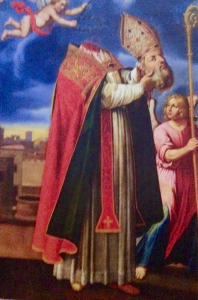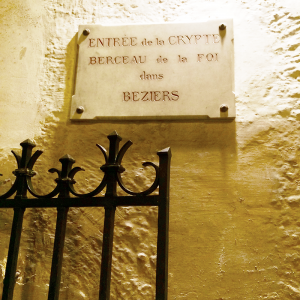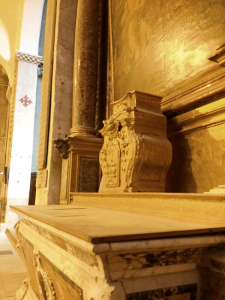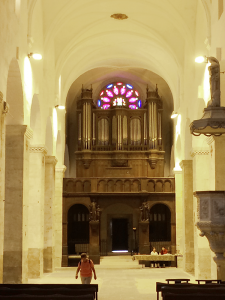Losing Our Heads Over French History
By Michele Reed
michele@cny55.com
Photos by Bill Reed

Marie Antoinette isn’t the only famous French person to lose her head. In Beziers, the city nearest to our French home, a bishop of the early Christian church lost his, too. One weekend this fall we got to discover a legendary church dedicated to him, exploring it literally from top to bottom.
It was the “Journees Europeenes de Patrimoine” or European Heritage Days. This annual event, the third weekend of every September, is the one weekend a year when cultural, historic and civic buildings, many normally closed to the public, give up their secrets. French people in cities, towns and even small villages come out in droves to learn about their heritage.
The French invented this wonderful weekend in 1984 as “La Journée Portes Ouvertes” — literally the day of the open doors — sponsored by the Ministry of Culture. It was later expanded to a whole weekend and adopted by the entire European Union so now you see Heritage Days in England, Germany, Netherlands and other countries.
We pored for days over the brochure of openings in Beziers. There were public gardens, churches, museums and theatres, all open to the public free of charge. There was even a working archeological site, but it was beyond our range without a car.
We planned an ambitious list, and then reality set in. How much walking could we reasonably expect to do in a day or part of one? We crossed off sites we had already seen, and the museums, since we could visit them on our own. Finally Bill and I settled on the one that fascinated us the most: the basilica church of St. Aphrodise, the first bishop of Beziers.
Medieval legends can be strange. Local lore has it that Aphrodise came from Egypt by camel to live in a cave as a holy man and preach to the people of Beziers, eventually becoming bishop. He was beheaded by a pagan mob. So the saint picked up his head and carried it, walking back to his cave, which is now the crypt of the basilica, housing his relics.

The highlight of this trip was venturing down into that crypt, our phones as the only lighting source, to see the replica of the saint’s head and the reliquary containing his remains. But I get ahead of myself. (Bad pun intended.)
The church of St. Aphrodise is closed to the public because it is in disrepair and only opens this one weekend a year. Approaching the main door we were already impressed — you could see the original outline of a huge Roman-era archway dwarfing the newer door, and carvings dating back nearly 2,000 years.
The interior is a renovation in progress. We had to step around ladders, tarps and electrical cords as we made our way around the church, but that only added to the sense of adventure. Some altars and pictures were already restored. Others were not. We could see frescoes peeling because of water damage; stained glass windows had pieces missing; the entire place smelled musty. And to us, it was awesome!
Both Bill and I studied history at university and my period was medieval, so I was in heaven. There were meters-high stained glass windows, carved reliquaries, a gilded Virgin and Child. There was a paleo-Christian stone tablet with the head of a woman alongside an ornate golden reliquary from the high Middle Ages, alongside Baroque carvings and a 20th-century crucifix sculpted by Beziers native Injalbert.
In true French “open door day” fashion, we could wander anywhere we wanted, and we did. A member of the Friends of St. Aphrodise was leading small tours, but in French, so we kept to ourselves. Often it’s more fun that way. Bill found his way behind the main altar, where an earlier altar, decorated in bronze reliefs, stood against the original Roman wall, flanked by plaques listing the local boys killed in World War I.

A narrow staircase of a half dozen steps led downward, and an engraved plaque told us this was the ancient “crypte” of the church. The gate was open, and although there was no electricity, the mysteries of the crypt beckoned. We turned on the flashlight function on our phones and headed down. It was a tiny stone basement, with an aisleway about a foot and half wide, curving in a small circle around the reliquary of the saint’s bones. One side of the passageway featured a niche with a replica of his head, the other side, part of an ancient cross and other items. It was a tiny space to hold such an outsized legend.
After we had wandered around to our hearts’ content, I conceived the brilliant idea of exploring the organ. Some ladies were selling souvenirs in front of the organ loft. When I asked if we could go up to the organ, they referred me to the guide. With a mischievous look, he seemed to really consider and then gave us a Gallic shrug and said the French equivalent of “why not?”
The steps were so steep, and the ceiling so low, that we had to bend far enough down that our noses fairly touched the steps in front of us while the ceiling of the stairwell brushed our backs.
Soon we were standing at the front of the huge pipes and our guide revealed the keyboard, stops and pedals. We took some pictures, enjoyed a view of the church from our lofty vantage point and then headed back down. Our guide pointed out the bellows under the stairs where two people were employed to pump to keep the organ functioning in the days before electricity.
When we stepped back out into the autumn sunshine, we were astonished to see that it was already well after noon. We had spent nearly two hours exploring the ancient church, for the most part unguided and certainly unsupervised. It’s the kind of adventure we came to France to experience and we still can’t get it out of our heads.

Michele Reed retired after a career spanning four decades in public relations, advertising, journalism and higher education. She now writes travel articles, book reviews, haiku poetry and fiction. Bill Reed retired after four decades in social services with the county of Oswego, and now works at travel photography and photojournalism, along with writing book reviews.

